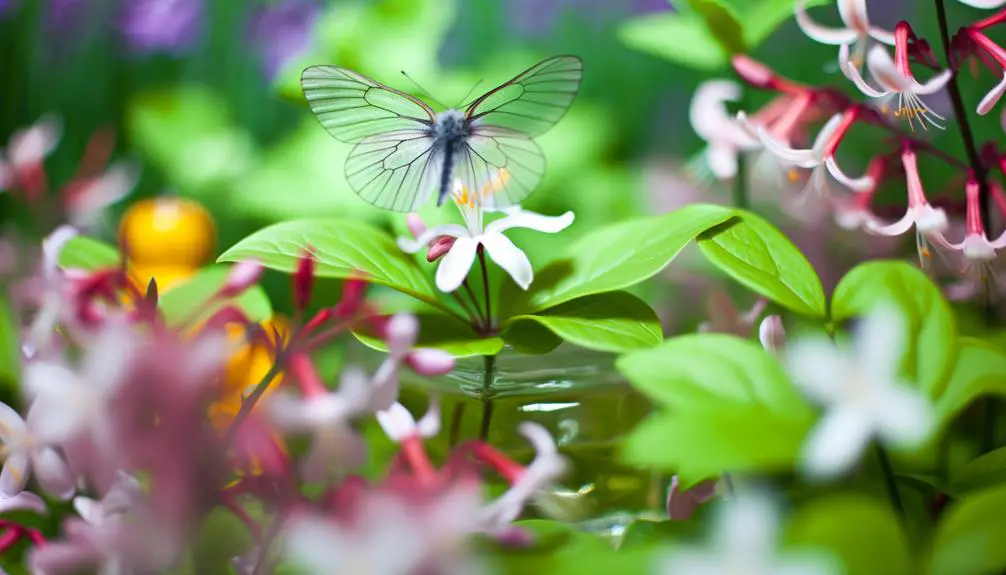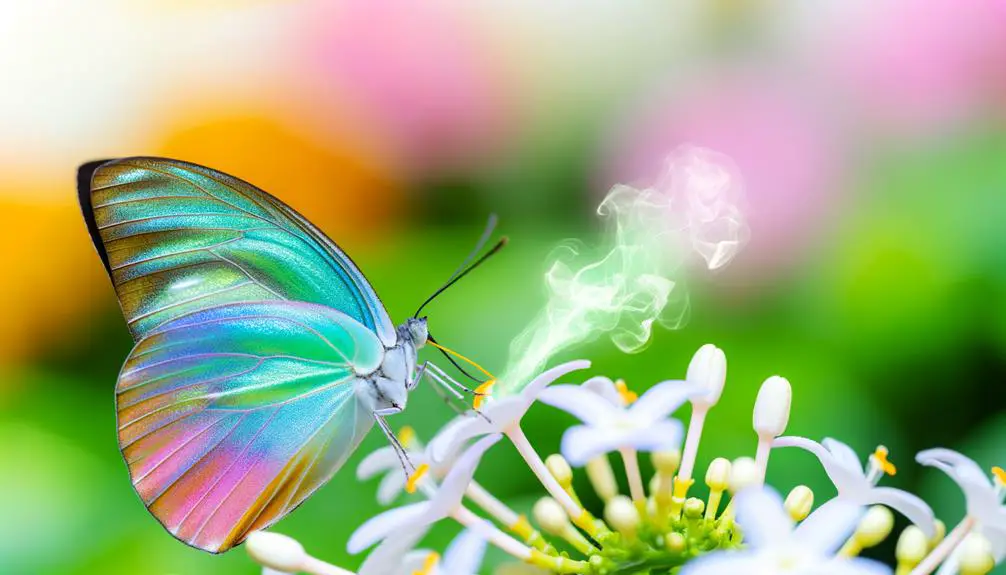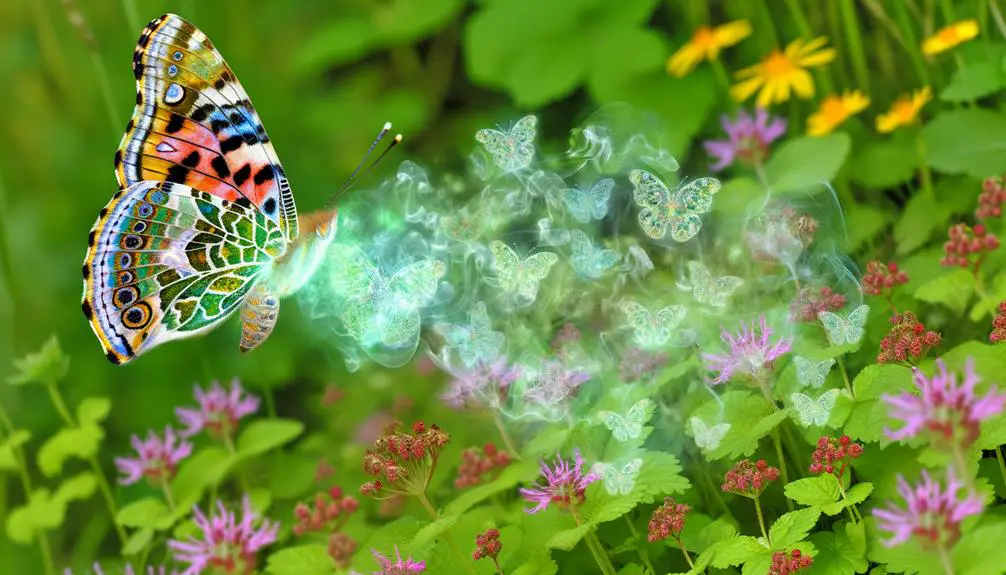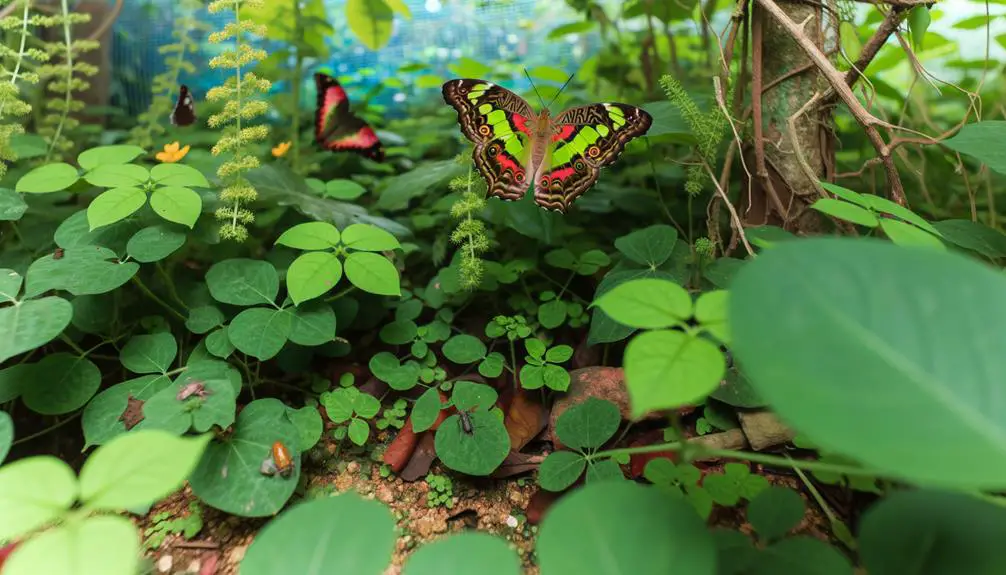How Do Butterflies Smell Like: A Sensory Exploration Guide
Butterflies release distinctive pheromones from their scent glands, significantly androconia, which play a key role in communication, mate attraction, and territorial behavior. These pheromones are composed of volatile organic compounds such as alcohols and esters, with specific blends including chemicals like methyl salicylate and hexadecanal.
Defensive odors are also emitted to deter predators, enhancing survival. Techniques such as gas chromatography-mass spectrometry (GC-MS) are used to precisely analyze these chemical compounds.
Understanding the intricate chemical communications of butterflies provides deeper insights into their ecological interactions and evolutionary adaptations. For further exploration of these fascinating mechanisms, continue following the discourse.

Key Takeaways
- Butterfly pheromones usually smell like volatile organic compounds such as alcohols and esters.
- Common scents include sweet, floral notes of methyl salicylate and subtle musky odors of hexadecanal.
- Defensive odors in caterpillars and adults can release foul-smelling, toxic compounds to deter predators.
- Androconia in males produce species-specific pheromones for mate attraction, often unnoticed by humans.
Butterfly Scent Basics

Butterflies utilize a complex system of pheromones and chemical signals for communication, mate attraction, and territorial behaviors. These chemosensory cues are critical for species-specific interactions and reproductive success.
Observational studies reveal that male butterflies often release pheromones from specialized structures called androconia, located on their wings or bodies, to attract females. Additionally, female butterflies emit distinct pheromones to indicate their readiness for mating.
Territorial males employ chemical markers to delineate and defend their habitat against rivals. Experimental evidence supports that these pheromones can affect behavior at remarkably low concentrations, underscoring their potency and efficiency.
Understanding these chemical communication mechanisms provides insights into the evolutionary adaptations and ecological interactions of butterfly species.
Chemical Composition
The chemical composition of butterfly pheromones comprises a diverse array of volatile organic compounds, including alcohols, aldehydes, esters, and hydrocarbons. These compounds serve as key signaling molecules in intraspecific communication, particularly during mating behaviors.
For example, male butterflies commonly release pheromones containing methyl salicylate and hexadecanal to attract females. Analytical techniques such as gas chromatography-mass spectrometry (GC-MS) have elucidated the specific molecular structures of these compounds, revealing their role in the complex olfactory systems of butterflies.
Moreover, studies have shown that the precise blend and concentration of these chemicals can markedly influence mating success, emphasizing their evolutionary importance. These findings underscore the intricate chemical ecology underlying butterfly behavior and interaction.
Scent Glands

Scent glands, also known as androconia, are specialized structures found in many butterfly species that play an essential role in the production and dissemination of pheromones. These glands, often located on the wings or abdomen, emit chemical signals vital for reproductive behavior and mate attraction. The following table highlights key characteristics of androconia in various butterfly families:
| Butterfly Family | Location of Scent Glands | Function |
|---|---|---|
| Nymphalidae | Forewings | Mate attraction |
| Pieridae | Hindwings | Courtship rituals |
| Papilionidae | Abdomen | Reproductive signaling |
| Lycaenidae | Forelegs | Species recognition |
| Hesperiidae | Hindwings | Territorial marking |
This intricate system underscores the evolutionary significance of chemical communication in butterflies, facilitating intricate mating systems and species-specific interactions.
Pheromones
Pheromones serve as essential biochemical signals, enabling butterflies to engage in complex behaviors such as mate selection, territory establishment, and species recognition.
Male butterflies often release pheromones from specialized scent glands located on their wings or abdomen, which are detected by female butterflies through their antennae.
Research has shown that these chemical cues are species-specific, ensuring accurate identification and successful reproduction. For example, studies on the monarch butterfly (Danaus plexippus) reveal that males emit a particular blend of volatile compounds to attract females.
Additionally, pheromones play a critical role in territorial behaviors, where males mark and defend their space.
Defensive Odors

Butterflies have evolved to produce defensive odors, which serve as a chemical deterrent against predators and enhance their survival.
These odors are primarily produced by specialized glands called osmeteria in caterpillars and by scent scales in adult butterflies.
For example, caterpillars of the swallowtail species release a pungent, unpleasant odor from their osmeteria when threatened. This secretion contains volatile organic compounds such as terpenoids and aliphatic acids, which are effective in repelling predators like birds and ants.
Adult butterflies, such as the monarch, utilize pyrrolizidine alkaloids derived from their larval host plants to produce toxic and foul-smelling compounds.
Empirical studies confirm that these chemical defenses considerably reduce predation rates, thereby contributing to the butterflies' evolutionary success.
Seasonal Variations
In addition to chemical defenses, butterflies exhibit remarkable seasonal variations in their behavior, physiology, and life cycles, which are adaptations to changing environmental conditions.
For instance, the Monarch butterfly (Danaus plexippus) undergoes extensive migratory patterns, traveling thousands of kilometers to overwintering sites in Mexico.
Physiological changes, such as diapause—a state of suspended development—occur in response to photoperiod and temperature fluctuations, ensuring survival during adverse weather.
Additionally, seasonal polyphenism is observed in species like the Common Buckeye (Junonia coenia), where morphological changes in wing coloration between summer and winter forms aid in thermoregulation and camouflage.
Such adaptations underscore the intricate interplay between butterflies and their ever-changing habitats, highlighting the complexity of their survival strategies.
Floral Mimicry

Remarkably, floral mimicry in butterflies involves complex evolutionary adaptations that enable these insects to resemble flowers, consequently enhancing their ability to evade predators and increase reproductive success.
This phenomenon is particularly evident in species like the orchid mimic butterfly, whose wing patterns and colors closely resemble specific floral structures.
Through detailed observations, researchers have noted that these butterflies not only adopt the visual cues of flowers but also emit chemical signals similar to floral scents, thereby deceiving both predators and pollinators.
Evidence-based studies demonstrate that such mimicry considerably reduces predation risks while simultaneously facilitating access to nectar sources.
This dual advantage underscores the intricate evolutionary strategies butterflies employ to survive and thrive in their ecological niches.
Mate Attraction
The intricate mechanisms of mate attraction in butterflies encompass a combination of visual, chemical, and behavioral cues that have been honed through evolutionary processes to maximize reproductive success.
Male butterflies often exhibit vibrant coloration and specific flight patterns to attract females. Chemically, pheromones play a pivotal role; males release these volatile compounds to signal their presence and readiness to mate.
Detailed observations have demonstrated that these pheromones can vary considerably between species, ensuring species-specific attraction. In addition, females are known to respond selectively to these cues, ensuring ideal mate choice.
Studies have shown that these sensory modalities are critical for successful mating, with disruptions potentially leading to decreased reproductive rates and population declines, highlighting their evolutionary importance.
Predator Deterrence

Butterflies employ a range of sophisticated strategies to deter predators, including aposematic coloration, mimicry, and chemical defenses. These mechanisms are critical for survival and have been extensively documented in entomological studies.
Key deterrent strategies include:
- Aposematic Coloration: Bright colors signal toxicity, warning potential predators.
- Batesian Mimicry: Non-toxic butterflies mimic the appearance of toxic species to avoid predation.
- Chemical Defenses: Certain species produce or sequester toxic compounds from host plants, rendering them unpalatable.
These adaptive features, supported by empirical evidence, contribute greatly to reducing predation risk, thereby enhancing the butterflies' evolutionary fitness and ecological success.
Human Perception
Human perception of butterflies is influenced by sensory experience variability and their association with diverse environments. This perception is shaped by cultural symbolism, personal encounters, and ecological contexts. The habitats where butterflies sleep, such as dense foliage or tree bark, also contribute to their mystique, as these resting places often go unnoticed. Their vivid colors and delicate movements further enhance their appeal, making them a subject of fascination across different societies.
Studies indicate that the vibrant coloration and erratic flight patterns of butterflies enhance visual stimulation, contributing to their aesthetic appeal.
Additionally, butterflies are often perceived as indicators of ecological health, linking their presence to well-preserved natural habitats.
Sensory Experience Variability
Perceptual experiences of butterflies' colors can vary greatly among humans due to differences in individual visual acuity and color vision deficiencies. Variability in sensory experiences is influenced by several factors, including:
Genetic variations: Differences in genes responsible for photopigments can lead to color vision anomalies.
Aging: The yellowing of the lens and other age-related changes can alter color perception.
Environmental factors: Light conditions and background colors can considerably impact the perceived color of butterflies.
Neurological conditions: Disorders such as synesthesia can alter the perception of sensory stimuli.
These factors contribute to a diverse range of visual experiences among individuals, making the subjective experience of butterfly colors a unique phenomenon for each observer.
Understanding these variations is essential for accurately interpreting human sensory data.
Association With Environments
The perception of butterflies' colors is intricately linked to their surrounding environments, as background hues, ambient light, and habitat-specific elements can greatly influence visual interpretations.
In dense forests, the interplay of light and shadow can enhance or obscure the vibrancy of wing patterns, affecting detectability. Conversely, open fields with abundant sunlight may amplify iridescent qualities, making butterflies more conspicuous.
Research indicates that human observers often perceive butterflies in relation to floral abundance and plant diversity, which can lead to associations between butterfly species and specific aromatic environments.
This sensory coupling suggests that humans may subconsciously link the visual beauty of butterflies with the olfactory stimuli of their habitats, thereby enriching the overall perceptual experience of encountering these insects.
Research Discoveries

Recent research has yielded significant insights into the sophisticated olfactory mechanisms of butterflies, revealing complex scent identification methods.
Detailed observations using electron microscopy have documented the intricacies of their antennal sensilla, which are essential for detecting pheromones and environmental odors.
These scientific findings underscore the critical role of olfaction in butterfly behavior and ecological interactions.
Scientific Findings
Advancements in entomological research have disclosed intricate details about butterfly navigation, revealing their reliance on a combination of solar cues and magnetic fields for long-distance migration.
Studies have underscored the role of the following:
- Solar Orientation: Butterflies use the sun as a compass to maintain their migratory path.
- Magnetic Sensitivity: Certain species possess magnetoreceptors, aiding in orientation by detecting Earth's geomagnetic field.
- Visual Landmarks: Butterflies recognize and utilize distinct terrestrial features for navigation.
These discoveries provide a thorough understanding of the multifaceted strategies butterflies employ to traverse vast distances, enhancing our knowledge of their ecological adaptations and evolutionary success.
Olfactory Mechanisms
In addition to their sophisticated navigational abilities, butterflies exhibit complex olfactory mechanisms that are pivotal for various behaviors, including foraging, mating, and oviposition.
Research has elucidated that butterflies possess highly sensitive olfactory receptors located primarily on their antennae, which enable them to detect and discriminate between specific volatile compounds.
For instance, studies using electroantennography have demonstrated that these receptors respond robustly to floral scents, facilitating efficient nectar foraging.
Furthermore, pheromone detection is critical during mating; male butterflies can identify female-emitted sex pheromones from considerable distances, thereby optimizing reproductive success.
The olfactory system also guides females in selecting oviposition sites, ensuring larvae access to appropriate host plants.
These findings underscore the integral role of olfaction in butterfly ecology and behavior.
Scent Identification Methods
Emerging research has employed advanced techniques such as gas chromatography-mass spectrometry (GC-MS) and electroantennography (EAG) to dissect the molecular composition of scents detected by butterfly olfactory receptors.
These methodologies have enabled scientists to map olfactory pathways and identify specific volatile compounds that elicit behavioral responses in butterflies. Through GC-MS, researchers can separate and analyze complex scent mixtures, while EAG measures the electrical response of an antenna to these compounds.
- GC-MS: Used to separate and identify volatile organic compounds in scents.
- EAG: Measures electrical activity in response to odorous stimuli.
- Behavioral assays: Examine how butterflies react to specific scents.
These approaches have greatly advanced our understanding of butterfly olfaction.
Conclusion
Ironically, the olfactory landscape of butterflies, which might be presumed inconsequential due to their delicate nature, reveals a complex interplay of chemical signals.
The presence of scent glands, pheromones, and defensive odors underscores the sophisticated mechanisms employed for mate attraction and predator deterrence.
Human perception of these scents remains limited, yet scientific inquiry continues to uncover the nuanced roles they play.
Consequently, butterflies, often celebrated for their visual beauty, also exhibit a remarkable and intricate olfactory dimension.





